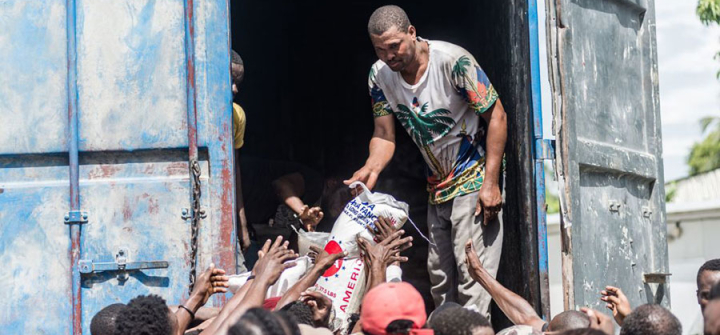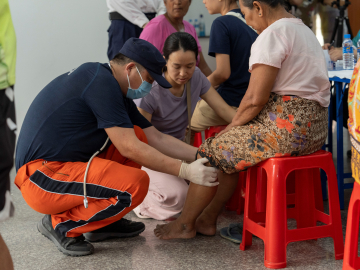No ‘Silver Lining’: The Media’s Disaster Narrative in Haiti and Beyond
“It felt like a time-warp.”
That’s how Dayanne Darnier, director of the Haitian-based nonprofit Fleur de Vie, described the August 14 earthquake that devastated southern Haiti. Fear engulfed her as she watched the ground outside her building vigorously shaking. It was the same exact fear that many Haitians experienced during the earthquake in 2010.
Within minutes, news of the 7.2 magnitude earthquake spread like wildfire across the country and the world. News outlets said the epicenter of the earthquake—the southern department of Haiti that includes cities such as Les Cayes and Jeremie —was “the poorest in Haiti.” As the news broke that Saturday morning, a reporter for a popular American news outlet said that there was a “silver lining” given that the earthquake occurred in one of the poorest regions of Haiti as opposed to the capital of Port-au-Prince.
There is never a “silver lining” when thousands of lives are taken unexpectedly, when families cannot recover their loved ones trapped under rubble, or when entire towns, cities, and historic structures are destroyed.
While many of news outlets had good intentions, the way humanitarian crises are framed must change. When tragedy unexpectedly strikes, particularly in the context of the political turmoil Haiti has experienced over the last month, it is irresponsible to devalue the impact of a catastrophe because the affected area is economically disadvantaged or less inhabited. This has been a common theme in media reports of disaster relief efforts. Too often, the media paints areas enduring humanitarian crises as poor or economically disadvantaged without shedding light on the area’s history, culture, or describing the people living within it.
To provide deeper context, the southern region of Haiti holds considerable historical significance to the country. Traveling southwest of Port-au-Prince will lead you to the city of Jacmel. Though many news outlets only described it as “poor,” Jacmel is known as “The City of Light” and revered for its gingerbread architecture and contrasting color schemes that made it a candidate World Heritage Site in 2004. As you go further west from Jacmel (toward the earthquake’s epicenter), you reach Les Cayes home to Pic Macaya (the second highest point in Haiti) and Saut-Mathurine (the largest waterfall in the country). Also devastated by the earthquake, Jeremie is known as “The City of Poets” due to the sheer number of prominent Haitian historians, writers, artists, and poets who originated there. The history and lush landscape of the southern region of Haiti generated a large influx of tourism, offsetting severe declines elsewhere over the last year due to political instability. While these areas may be economically poor and less populated than Port-au-Prince, they are rich culturally and historically. For many Haitians across the diaspora, these areas hold deep meaning.
For Dayanne, there certainly is no silver lining in Anse-a-Veau, a small town in the earthquake’s epicenter. Dayanne and team members from Fleur de Vie, the nonprofit she founded in 2010, had spent five years working on redevelopment plans and strengthening afterschool programs for her partner institution Ecole Jeannou Flyer S’Eden in Anse-a-Veau. Their work at the primary school crumbled within seconds. Since the earthquake, it’s been continuous back and forth WhatsApp messages between her U.S. and Haiti team on logistics needed to get emergency supplies to those in need in Anse-a-Veau, where those who lost their homes were left to face the elements of Tropical Storm Grace less than 48 hours after the earthquake.
If there is any silver lining, it is that Haitians are resilient and have overcome tremendous challenges as the first independent Black nation in the world. The strength of the Haitian people was heavily emphasized during the earthquake in 2010 and has been a recurring theme in the media after this recent catastrophe. But there is only so much devastation one can experience before reaching a breaking point mentally, emotionally, and physically.
There needs to be a paradigm shift in the way global health and humanitarian crises are reported. The narrative needs to pull away from framing such crises as issues affecting the poor and instead emphasize these crises as issues affecting our peers and fellow global citizens. The human element of those who have been impacted must be emphasized. News outlets must provide deeper context regarding the areas affected by humanitarian crises, and most importantly humanize the individuals who are impacted.
Dominique Guillaume (@dom_rolland) is a PhD student at Johns Hopkins School of Nursing, a Global Women’s Health Fellow with Jhpiego, and a board member with the global health nonprofit organization Fleur de Vie. She has spent the last decade working on public health and disaster relief initiatives throughout Haiti. Outside of her public health work, she has traveled extensively throughout the southern region of Haiti with her family who resides there.
Dayanne Darnier is the founder and executive director of the global health nonprofit organization Fleur de Vie. She can be reached via ([email protected] and on Twitter @fleurdevieOrg).
Join the 50,000+ subscribers in 170+ countries who rely on Global Health NOW summaries and exclusive articles for the latest public health news. Sign up for our free weekday newsletter, and please share the link with friends and colleagues.
A man gives a bag of rice to a crowd of earthquake victims gathered for the distribution of food and water at the "4 Chemins" crossroads in Les Cayes, Haiti on August 20, 2021. Image: Reginald Louissaint Jr./AFP/Getty




